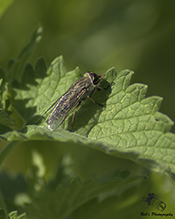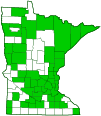True horse flies
(Tabanus spp.)
Overview • Description • Distribution • Taxonomy

Overview
Tabanus is a genus of large, stout-bodied flies known as true horse flies. There are at least 1,358 species of Tabanus worldwide, but the exact number is unknown. There are more than 100 species in North America north of Mexico, and at least 12 species in Minnesota. Adults are often found near ponds, steams, and marshes. Larvae are aquatic.
Adults are active in the spring and summer. Females feed on the blood of larger mammals. They seldom bite humans, but when they do the experience is painful and remembered. They can be silent when flying, allowing them to land stealthily on exposed skin. Males feed on flower nectar.
.
Description
The body is usually gray or blackish. The wings usually do not have dark spots, though in some species the wings are entirely black. The eyes of many species are brightly colored or iridescent. Some are bright green, some are striped. The eyes of the male meet, while those of the female are separated. The antennae have only three segments. The third segment is elongated and subdivided, and has a basal tooth-like projection. The fourth segment of the hind leg does not have spurs at the top (apex). The last segment of the foot (tarsus) has 3 pads.
Distribution |
||
|
Sources Biodiversity occurrence data published by: Minnesota Biodiversity Atlas (accessed through the Minnesota Biodiversity Atlas Portal, bellatlas.umn.edu, 10/9/2025). |
|
| 10/9/2025 | ||
Taxonomy
Order
Suborder
Brachycera
Infraorder
Orthorrhapha
Parvorder
Tabanomorpha (snipe flies and allies)
Superfamily
Tabanoidea
Family
Tabanidae (horse and deer flies)
Subfamily
Tabaninae (horse flies)
Tribe
Tabanini
Subordinate Taxa
black horse fly (Tabanus atratus) ![]()
brown-footed horse fly (Tabanus fulvicallus) ![]()
chained horse fly (Tabanus catenatus) ![]()
horse fly (Tabanus turbidus) ![]()
marginal horse fly (Tabanus marginalis) ![]()
Nova Scotia horse fly (Tabanus novaescotiae) ![]()
Reinwardt’s horse fly (Tabanus reinwardtii) ![]()
sage horse fly (Tabanus sagax) ![]()
similar horse fly (Tabanus similis) ![]()
striped horse fly (Tabanus lineola) ![]()
stygian horse fly (Tabanus stygius) ![]()
three-spotted horse fly (Tabanus trimaculatus) ![]()
Synonyms
Alliomma Borgmeier
Astigmatophthalmus
Ballardia
Bellaria
Brachypsalidia
Callotabanus
Chelommia
Chelotabanus
Gymnochela
Hybostraba
Lophotabanus
Macrocormus
Neotabanus
Odontotabanus
Phyrta
Straba
Styporhamphis
Taeniotabanus
Common Names
true horse flies
greenhead
Glossary
Tarsus
On insects, the last two to five subdivisions of the leg, attached to the tibia; the foot. On spiders, the last segment of the leg. Plural: tarsi.
Tibia
The fourth segment of an insect leg, after the femur and before the tarsus (foot). The fifth segment of a spider leg or palp. Plural: tibiae.
Visitor Photos
Share your photo of this insect.
This button not working for you?
Simply email us at info@MinnesotaSeasons.com.
Attach one or more photos and, if you like, a caption.
Bill Reynolds |
 |
An image of a biter! The dreaded Horse Fly as she waits for the next victim |
MinnesotaSeasons.com Photos
|

Slideshows

Visitor Videos
Share your video of this insect.
This button not working for you?
Simply email us at info@MinnesotaSeasons.com.
Attach a video, a YouTube link, or a cloud storage link.
Other Videos
Horsefly (Tabanus) larva crawling and digging in the mud
Nature in Motion
Horse Fly (Tabanidae: Tabanus) in Hand
Carl Barrentine
Horse-fly bites and wounds me: an experiment and explanation
WorldScott
Horse Fly (Tabanidae: Tabanus) Behavior
Carl Barrentine
Horse Fly (Tabanidae: Tabanus) on Wall
Carl Barrentine

Visitor Sightings
Report a sighting of this insect.
This button not working for you?
Simply email us at info@MinnesotaSeasons.com.
Be sure to include a location.


